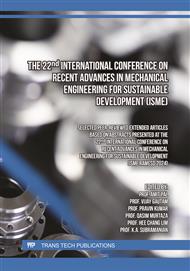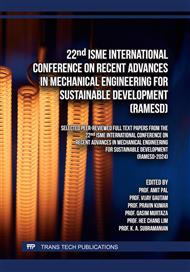[1]
Sharma, K. V., Straka, R., and Tavares, F. W., "Lattice Boltzmann Methods for Industrial Applications," Industrial & Engineering Chemistry Research, Vol. 58, No. 36, 2019, p.16205–16234
DOI: 10.1021/acs.iecr.9b02008
Google Scholar
[2]
Perumal, D. A., and Dass, A. K., "A Review on the Development of Lattice Boltzmann Computation of Macro Fluid Flows and Heat Transfer," Alexandria Engineering Journal, Vol. 54, No. 4, 2015, p.955–971
DOI: 10.1016/j.aej.2015.07.015
Google Scholar
[3]
Li, L., Lu, J., Fang, H., Yin, Z., Wang, T., Wang, R., Fan, X., Zhao, L., Tan, D., and Wan, Y., "Lattice Boltzmann Method for Fluid-Thermal Systems: Status, Hotspots, Trends and Outlook," Ieee Access, Vol. 8, 2020, p.27649–27675
DOI: 10.1109/access.2020.2971546
Google Scholar
[4]
Nourgaliev, R. R., Dinh, T.-N., Theofanous, T. G., and Joseph, D., "The Lattice Boltzmann Equation Method: Theoretical Interpretation, Numerics and Implications," International Journal of Multiphase Flow, Vol. 29, No. 1, 2003, p.117–169
DOI: 10.1016/s0301-9322(02)00108-8
Google Scholar
[5]
Mattila, K., Hyväluoma, J., Timonen, J., and Rossi, T., "Comparison of Implementations of the Lattice-Boltzmann Method," Computers & Mathematics with Applications, Vol. 55, No. 7, 2008, p.1514–1524
DOI: 10.1016/j.camwa.2007.08.001
Google Scholar
[6]
Noelting, S., and Fares, E., "The Lattice-Boltzmann Method: An Alternative to LES for Complex Aerodynamic and Aeroacoustic Simulations in the Aerospace Industry," SAE Technical Paper, 2015
DOI: 10.4271/2015-01-2575
Google Scholar
[7]
Su, J., "Improved Lumped Models for Asymmetric Cooling of a Long Slab by Heat Convection," International communications in heat and mass transfer, Vol. 28, No. 7, 2001, p.973–983
DOI: 10.1016/s0735-1933(01)00301-3
Google Scholar
[8]
Alhama, F., and Campo, A., "The Connection between the Distributed and Lumped Models for Asymmetric Cooling of Long Slabs by Heat Convection," International Communications in Heat and Mass Transfer, Vol. 28, No. 1, 2001, p.127–137
DOI: 10.1016/s0735-1933(01)00220-2
Google Scholar
[9]
Baı̈ri, A., and Laraqi, N., "Diagrams for Fast Transient Conduction in Sphere and Long Cylinder Subject to Sudden and Violent Thermal Effects on Its Surface," Applied Thermal Engineering, Vol. 23, No. 11, 2003, p.1373–1390
DOI: 10.1016/s1359-4311(03)00086-3
Google Scholar
[10]
Chen, H., and Chen, C., "Hybrid Laplace Transform/Finite Difference Method for Transient Heat Conduction Problems," International Journal for Numerical Methods in Engineering, Vol. 26, No. 6, 1988, p.1433–1447
DOI: 10.1080/10407788808913648
Google Scholar
[11]
Sadat, H., "A General Lumped Model for Transient Heat Conduction in One-Dimensional Geometries," Applied Thermal Engineering, Vol. 25, No. 4, 2005, p.567–576
DOI: 10.1016/j.applthermaleng.2004.06.018
Google Scholar
[12]
Sadat, H., "A Second Order Model for Transient Heat Conduction in a Slab with Convective Boundary Conditions," Applied thermal engineering, Vol. 26, Nos. 8–9, 2006, p.962–965
DOI: 10.1016/j.applthermaleng.2005.10.013
Google Scholar
[13]
Sahu, S. K., and Behera, P., "An Improved Lumped Model for Transient Heat Conduction in Different Geometries," Computational Thermal Sciences: An International Journal, Vol. 4, No. 1, 2012
DOI: 10.1615/computthermalscien.2012003739
Google Scholar
[14]
Onur, N., and Sivrioglu, M., "Transient Heat Conduction with Uniform Heat Generation in a Slab Subjected to Convection and Radiation Cooling," Wärme-und Stoffübertragung, Vol. 28, No. 6, 1993, p.345–349
DOI: 10.1007/bf01539532
Google Scholar
[15]
Assad, M. E. H., "Entropy Generation Analysis in a Slab with Non-Uniform Heat Generation Subjected to Convection Cooling," International Journal of Exergy, Vol. 9, No. 3, 2011, p.355–369
DOI: 10.1504/ijex.2011.043044
Google Scholar
[16]
An, C., and Su, J., "Lumped Parameter Model for One-Dimensional Melting in a Slab with Volumetric Heat Generation," Applied thermal engineering, Vol. 60, Nos. 1–2, 2013, p.387–396
DOI: 10.1016/j.applthermaleng.2013.07.018
Google Scholar
[17]
Dai, B., Zheng, B., Liang, Q., and Wang, L., "Numerical Solution of Transient Heat Conduction Problems Using Improved Meshless Local Petrov–Galerkin Method," Applied Mathematics and Computation, Vol. 219, No. 19, 2013, p.10044–10052
DOI: 10.1016/j.amc.2013.04.024
Google Scholar
[18]
Sahu, S. K., and Behera, P., "An Improved Lumped Analysis for Transient Heat Conduction in Different Geometries with Heat Generation," Comptes Rendus Mécanique, Vol. 340, No. 7, 2012, p.477–484
DOI: 10.1016/j.crme.2012.03.006
Google Scholar
[19]
Mishra, S. C., Mondal, B., Kush, T., and Krishna, B. S. R., "Solving Transient Heat Conduction Problems on Uniform and Non-Uniform Lattices Using the Lattice Boltzmann Method," International Communications in Heat and Mass Transfer, Vol. 36, No. 4, 2009, p.322–328
DOI: 10.1016/j.icheatmasstransfer.2009.01.001
Google Scholar
[20]
Kałuża, G., "The Numerical Solution of the Transient Heat Conduction Problem Using the Lattice Boltzmann Method," Scientific Research of the Institute of Mathematics and Computer Science, Vol. 11, No. 1, 2012, p.23–30
DOI: 10.17512/jamcm.2012.1.03
Google Scholar
[21]
Incropera, F. P., DeWitt, D. P., Bergman, T. L., and Lavine, A. S., "Fundamentals of Heat and Mass Transfer," Wiley New York, 1996. https://doi.org/ISBN: 978-1-119-35388-1
Google Scholar
[22]
Timm, K., Kusumaatmaja, H., Kuzmin, A., Shardt, O., Silva, G., and Viggen, E., "The Lattice Boltzmann Method: Principles and Practice," Cham, Switzerland: Springer International Publishing AG, 2016
DOI: 10.1007/978-3-319-44649-3
Google Scholar
[23]
Mohamad, A. A., "Lattice Boltzmann Method," Springer, 2011
DOI: 10.1007/978-0-85729-455-5
Google Scholar
[24]
Wolf-Gladrow, D., "A Lattice Boltzmann Equation for Diffusion," Journal of statistical physics, Vol. 79, No. 5, 1995, p.1023–1032
DOI: 10.1007/bf02181215
Google Scholar
[25]
Wolf-Gladrow, D. A., "Lattice-Gas Cellular Automata and Lattice Boltzmann Models: An Introduction," Springer, 2004
DOI: 10.1007/b72010
Google Scholar
[26]
Sahu, A., and Bhowmick, S., "Numerical Investigation of Transient Responses of Triangular Fins Having Linear and Power Law Property Variation under Step Changes in Base Temperature and Base Heat Flux Using Lattice Boltzmann Method," Numerical Heat Transfer, Part A: Applications, Vol. 80, No. 5, 2021, p.234–254
DOI: 10.1080/10407782.2021.1940010
Google Scholar
[27]
Sahu, A., and Bhowmick, S., "Transient Response of Longitudinal Fins under Step Changes in Base Temperature and Heat Flux Using Lattice Boltzmann Method," Journal of Applied and Computational Mechanics, Vol. 8, No. 3, 2020, p.925–939
DOI: 10.1080/10407782.2021.1940010
Google Scholar



